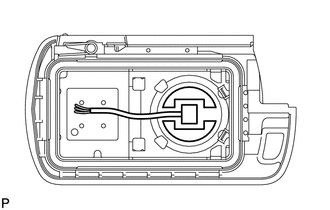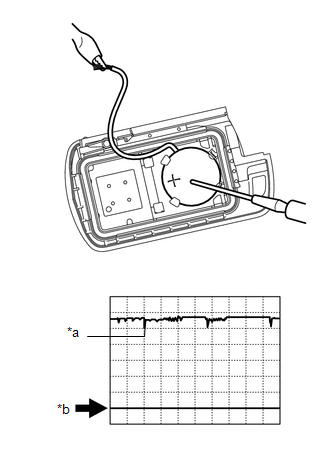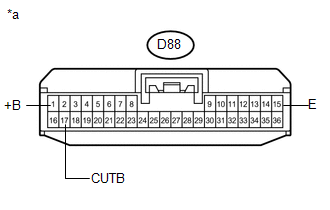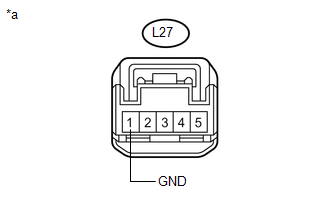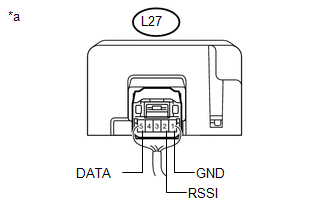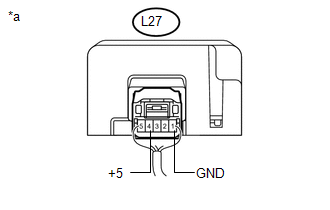- Engine switch off
- All doors locked
- Lock or unlock switch on key not pushed
| Last Modified: 08-28-2024 | 6.11:8.1.0 | Doc ID: RM100000000VJKH |
| Model Year Start: 2016 | Model: Sienna | Prod Date Range: [12/2015 - ] |
| Title: THEFT DETERRENT / KEYLESS ENTRY: SMART KEY SYSTEM(for Entry Function): All Door Entry Lock/Unlock Functions and Wireless Functions do not Operate; 2016 - 2020 MY Sienna [12/2015 - ] | ||
|
All Door Entry Lock/Unlock Functions and Wireless Functions do not Operate |
DESCRIPTION
When the entry door lock and unlock functions and wireless door lock and unlock functions do not operate, radio wave interference, or a malfunction in the key or signal circuit between the door control receiver assembly and certification ECU (smart key ECU assembly) is suspected. The signal circuit is shared by the entry function and wireless door lock function.
WIRING DIAGRAM
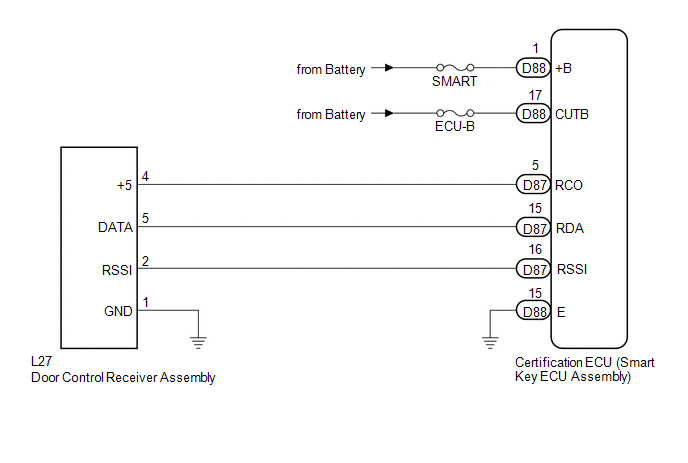
CAUTION / NOTICE / HINT
NOTICE:
-
The smart key system (for entry function) uses a multiplex communication system (LIN communication system) and CAN communication system. Inspect the communication function by following How to Proceed with Troubleshooting (See page
![2016 - 2020 MY Sienna [12/2015 - ]; THEFT DETERRENT / KEYLESS ENTRY: SMART KEY SYSTEM(for Entry Function): HOW TO PROCEED WITH TROUBLESHOOTING](/t3Portal/stylegraphics/info.gif) ). Troubleshoot the smart key system (for entry function) after confirming that the communication system is functioning properly.
). Troubleshoot the smart key system (for entry function) after confirming that the communication system is functioning properly.
-
Before performing the inspection, check that DTC B1242 (wireless door lock control) is not output (See page
![2016 - 2020 MY Sienna [12/2015 - ]; DOOR LOCK: WIRELESS DOOR LOCK CONTROL SYSTEM(w/ Smart Key System): B1242; Wireless Door Lock Tuner Circuit Malfunction](/t3Portal/stylegraphics/info.gif) ).
).
- Confirm that another key is not in the cabin.
- Inspect the fuses for circuits related to this system before performing the following inspection procedure.
PROCEDURE
|
1. |
CHECK POWER DOOR LOCK OPERATION |
(a) When the door control switch on the master switch assembly is operated, check that the doors unlock and lock according to switch operation (See page
![2016 - 2020 MY Sienna [12/2015 - ]; DOOR LOCK: POWER DOOR LOCK CONTROL SYSTEM: OPERATION CHECK](/t3Portal/stylegraphics/info.gif) ).
).
OK:
Door locks operate normally.
| NG |

|
GO TO POWER DOOR LOCK CONTROL SYSTEM (Proceed to Problem Symptoms Table) |
|
|
2. |
CHECK ELECTRICAL KEY TRANSMITTER |
(a) Check if another registered key is available.
|
Result |
Proceed to |
|---|---|
|
Another registered key is not available. |
A |
|
Another registered key is available. |
B |
| B |

|
|
|
3. |
REGISTER ELECTRICAL KEY TRANSMITTER |
(a) Register a new key (See page
![2016 MY Sienna [12/2015 - 08/2016]; THEFT DETERRENT / KEYLESS ENTRY: ENGINE IMMOBILISER SYSTEM(w/ Smart Key System): REGISTRATION](/t3Portal/stylegraphics/info.gif)
![2017 - 2020 MY Sienna [08/2016 - ]; THEFT DETERRENT / KEYLESS ENTRY: ENGINE IMMOBILISER SYSTEM(w/ Smart Key System): REGISTRATION](/t3Portal/stylegraphics/info.gif) ).
).
|
|
4. |
CHECK ELECTRICAL KEY TRANSMITTER (OPERATION) |
(a) Using the key registered in the previous step or another registered key, check that the entry function operates normally (See page
![2016 - 2020 MY Sienna [12/2015 - ]; THEFT DETERRENT / KEYLESS ENTRY: SMART KEY SYSTEM(for Entry Function): OPERATION CHECK](/t3Portal/stylegraphics/info.gif) ).
).
OK:
Entry function operates normally.
| NG |

|
|
|
5. |
CHECK ELECTRICAL KEY TRANSMITTER (LED) |
(a) Check that the transmitter LED illuminates each time when the switch is pushed 3 times.
|
Result |
Proceed to |
|---|---|
|
Transmitter LED does not illuminate at all when switch is pushed 3 times. |
A |
|
Transmitter LED illuminates each time when switch is pushed 3 times. |
B |
|
Transmitter LED does not illuminate the second or third time. |
C |
HINT:
If the transmitter LED does not illuminate the second or third time, replace the transmitter battery because it is depleted.
| B |

|
REPLACE ELECTRICAL KEY TRANSMITTER |
| C |

|
|
|
6. |
INSPECT TRANSMITTER BATTERY (VOLTAGE) |
(b) Carefully pull the lead wire out from the position shown in the illustration and install the previously removed transmitter battery.
|
(c) Using an oscilloscope, check the transmitter battery voltage waveform. HINT: When measuring the battery voltage, while operating the lock switch of a door outside handle assembly, bring the key within the entry operating range to perform the measurement. For the entry operating range, refer to System Description (See page
Standard Voltage:
Text in Illustration
|
|
| OK |

|
REPLACE ELECTRICAL KEY TRANSMITTER |
| NG |

|
|
7. |
CHECK WAVE ENVIRONMENT |
(a) Bring the key near the door control receiver, and check the wireless function.
HINT:
- When the key is brought near the door control receiver, the possibility of wave interference decreases, and it can be determined if wave interference is causing the problem symptom.
- If the inspection result indicates that the problem only occurs in certain locations or times of day, the possibility of wave interference is high. Also, added vehicle components may cause wave interference. If installed, remove them and perform the operation check.
OK:
Wireless function operates normally.
| OK |

|
AFFECTED BY WAVE INTERFERENCE |
|
|
8. |
CHECK POWER SOURCE |
(a) Check if functions other than the entry function operate when the engine switch is off.
|
Result |
Proceed to |
|---|---|
|
Other functions do not operate. |
A |
|
Other functions operate. |
B |
HINT:
Perform this check with using functions that do not require the engine switch to be on (ACC or IG) in order to operate.
| B |

|
GO TO SMART KEY SYSTEM (for Start Function) (Proceed to How to Proceed with Troubleshooting) |
|
|
9. |
CHECK HARNESS AND CONNECTOR (CERTIFICATION ECU - BATTERY AND BODY GROUND) |
|
(a) Disconnect the certification ECU (smart key ECU assembly) connector. |
|
(b) Measure the voltage and resistance according to the value(s) in the table below.
Standard Voltage:
|
Tester Connection |
Condition |
Specified Condition |
|---|---|---|
|
D88-1 (+B) - Body ground |
Always |
11 to 14 V |
|
D88-17 (CUTB) - Body ground |
Always |
11 to 14 V |
Standard Resistance:
|
Tester Connection |
Condition |
Specified Condition |
|---|---|---|
|
D88-15 (E) - Body ground |
Always |
Below 1 Ω |
Text in Illustration
|
*a |
Front view of wire harness connector (to Certification ECU (Smart Key ECU Assembly)) |
| NG |

|
REPAIR OR REPLACE HARNESS OR CONNECTOR |
|
|
10. |
CHECK HARNESS AND CONNECTOR (CERTIFICATION ECU - DOOR CONTROL RECEIVER) |
(a) Disconnect the door control receiver assembly connector.
(b) Measure the resistance according to the value(s) in the table below.
Standard Resistance:
|
Tester Connection |
Condition |
Specified Condition |
|---|---|---|
|
D87-5 (RCO) - L27-4 (+5) |
Always |
Below 1 Ω |
|
D87-15 (RDA) - L27-5 (DATA) |
Always |
Below 1 Ω |
|
D87-16 (RSSI) - L27-2 (RSSI) |
Always |
Below 1 Ω |
|
D87-5 (RCO) - Body ground |
Always |
10 kΩ or higher |
|
D87-15 (RDA) - Body ground |
Always |
10 kΩ or higher |
|
D87-16 (RSSI) - Body ground |
Always |
10 kΩ or higher |
|
L27-4 (+5) - Body ground |
Always |
10 kΩ or higher |
|
L27-5 (DATA) - Body ground |
Always |
10 kΩ or higher |
|
L27-2 (RSSI) - Body ground |
Always |
10 kΩ or higher |
| NG |

|
REPAIR OR REPLACE HARNESS OR CONNECTOR |
|
|
11. |
CHECK HARNESS AND CONNECTOR (DOOR CONTROL RECEIVER - BODY GROUND) |
|
(a) Measure the resistance according to the value(s) in the table below. Standard Resistance:
Text in Illustration
|
|
| NG |

|
REPAIR OR REPLACE HARNESS OR CONNECTOR |
|
|
12. |
INSPECT DOOR CONTROL RECEIVER ASSEMBLY (POWER SOURCE) |
(a) Reconnect the certification ECU (smart key ECU assembly) connector.
|
(b) Reconnect the door control receiver assembly connector. |
|
(c) Measure the voltage according to the value(s) in the table below.
Standard Voltage:
|
Tester Connection |
Condition |
Specified Condition |
|---|---|---|
|
L27-2 (RSSI) - L27-1 (GND) |
|
11 to 14 V |
|
L27-2 (RSSI) - L27-1 (GND) |
|
Below 2 V |
|
L27-5 (DATA) - L27-1 (GND) |
Engine switch off |
Pulse between 11 to 14 V occurs regularly |
Text in Illustration
|
*a |
Component with harness connected (Door Control Receiver Assembly) |
| NG |

|
REPLACE CERTIFICATION ECU (SMART KEY ECU ASSEMBLY) |
|
|
13. |
INSPECT DOOR CONTROL RECEIVER ASSEMBLY (DOOR CONTROL RECEIVER SIGNAL OUTPUT) |
|
(a) Measure the voltage according to the value(s) in the table below. Standard Voltage:
Text in Illustration
|
|
| OK |

|
REPLACE CERTIFICATION ECU (SMART KEY ECU ASSEMBLY) |
| NG |

|
|
|
|

